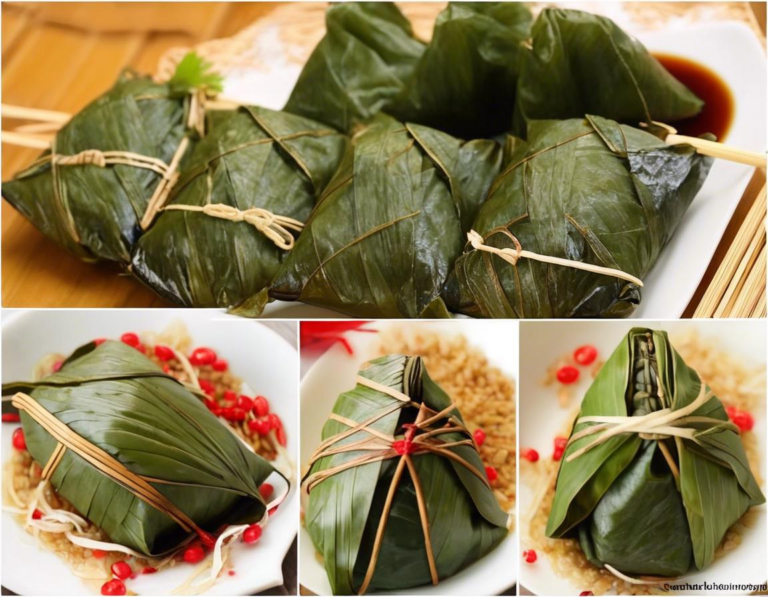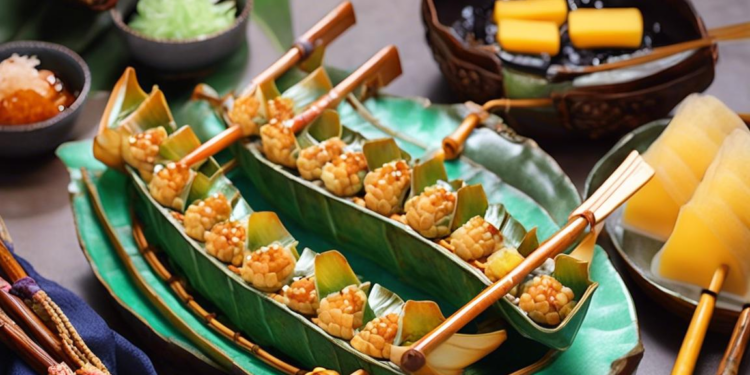How to Make Traditional Zongzi for Dragon Boat Festival

The Dragon Boat Festival, also known as Duanwu Jie, is a vibrant and ancient Chinese festival celebrated on the fifth day of the fifth lunar month. It’s a time for families and friends to gather, enjoy delicious food, and commemorate the life of the legendary poet Qu Yuan. One of the most iconic traditions of the festival is the making and sharing of zongzi, savory rice dumplings wrapped in bamboo leaves.
In this guide, we’ll delve into the art of making zongzi, covering everything from choosing the right ingredients to mastering the wrapping technique. By the end, you’ll be equipped to create your own delicious zongzi to enjoy during the Dragon Boat Festival or any time of year.
Understanding Zongzi: A Culinary Tradition
Zongzi is more than just a food; it’s a symbol of the Dragon Boat Festival and a testament to the ingenuity and culinary heritage of Chinese culture. The tradition of zongzi making dates back centuries, with the specific origin shrouded in folklore.
Here’s a glimpse into the story behind this beloved dish:
-
The Legend of Qu Yuan: The most popular legend attributes the creation of zongzi to a noble minister named Qu Yuan during the Warring States period. Qu Yuan was known for his patriotism and dedication to his country, but he was eventually forced into exile. On the fifth day of the fifth month, he drowned himself in the Miluo River to protest the corruption and injustice he witnessed. To prevent fish from eating his body, locals began throwing sticky rice wrapped in bamboo leaves into the river. This act of reverence eventually evolved into the tradition of zongzi making.
-
Zongzi as a Symbol: Beyond the legend, zongzi represents unity, family, and remembrance. The act of making and sharing these dumplings brings people together, symbolizing the shared history and cultural heritage of the Chinese people.
Zongzi Variations: A Culinary Tapestry
While the basic concept of zongzi remains the same—sticky rice wrapped in bamboo leaves—the fillings and cooking methods can vary widely across regions and families. This culinary diversity showcases the richness of Chinese cuisine and the adaptability of the zongzi tradition.
Here are some popular variations:
-
Sweet vs. Savory: Zongzi can be enjoyed in both sweet and savory flavors. Sweet zongzi are often filled with red bean paste, dates, or other sugary ingredients, while savory zongzi can feature meats like pork belly, chicken, or even seafood.
-
Regional Specialties: Each region in China has its own unique zongzi variations. For example, in the southern region, zongzi is often made with sticky rice and glutinous rice, while in the north, sticky millet is used.
-
Modern Innovation: Modern chefs and home cooks are constantly pushing the boundaries of zongzi creation, experimenting with new and exciting fillings and flavor combinations. Some popular contemporary variations include zongzi filled with cheese, vegetables, or even tofu.
Essential Ingredients for Traditional Zongzi:
Crafting the perfect zongzi starts with gathering the right ingredients. Here’s a list of essentials you’ll need:
1. Glutinous Rice (Sticky Rice): This is the foundation of zongzi. Glutinous rice, also known as sweet rice, has a high starch content, which allows it to bind together and form the shape of the dumpling.
2. Bamboo Leaves: These leaves provide both a unique flavor and a distinctive fragrance to the zongzi. Look for fresh, green bamboo leaves with a slightly waxy texture.
3. Filling: This is where you get to add your personal touch to the zongzi. Traditional fillings include:
- Pork Belly: Seasoned pork belly is a classic and popular filling choice for savory zongzi.
- Mushrooms: Shiitake mushrooms add a savory and umami flavor to the zongzi.
- Chestnuts: These provide a sweet and nutty flavor to the zongzi.
- Salted Duck Egg Yolk: This adds a rich, savory, and slightly salty flavor to the zongzi.
4. String or Rope: This is used to tie the zongzi closed, ensuring the filling stays securely within the bamboo leaves.
5. Optional Ingredients: You can also add other ingredients to enhance the flavor and texture of your zongzi. These include:
- Soy Sauce: Used to flavor the filling.
- Shaoxing Wine: Adds a fragrant aroma and helps tenderize the meat.
- Ginger: Adds a spicy and pungent flavor to the filling.
- Garlic: Adds a savory and pungent flavor to the filling.
- Scallions: Add a fresh and slightly sweet flavor to the zongzi.
Preparing the Bamboo Leaves:
Before you start wrapping your zongzi, it’s essential to prepare the bamboo leaves properly. This step ensures they are soft, pliable, and ready to encase the filling.
Here’s a step-by-step guide:
-
Cleaning the Leaves: Rinse the bamboo leaves under cold running water to remove any dirt or debris.
-
Softening the Leaves: Place the bamboo leaves in a large pot and cover them with water. Bring the water to a boil and then simmer for about 15 minutes. This process softens the leaves, making them easier to work with.
-
Draining and Cooling: Drain the bamboo leaves and allow them to cool slightly.
-
Trimming the Leaves: Trim the leaves to the desired size for wrapping your zongzi. You’ll typically need a square or rectangular piece of bamboo leaf for each dumpling.
Making the Filling for Savory Zongzi:
Now it’s time to assemble the filling for your zongzi. Here’s a recipe for a traditional savory filling:
Ingredients:
- 1 lb Pork Belly, cubed
- 1/2 cup Shiitake Mushrooms, rehydrated and sliced
- 1/4 cup Chestnuts, peeled and halved
- 1 Salted Duck Egg Yolk, optional
- 1 tbsp Soy Sauce
- 1 tbsp Shaoxing Wine
- 1 tsp Ginger, minced
- 1 clove Garlic, minced
- 1 scallion, chopped
Instructions:
-
Marinating the Pork: Combine the pork belly cubes, soy sauce, Shaoxing wine, ginger, garlic, and scallions in a bowl. Mix well and marinate for at least 30 minutes.
-
Sautéing the Filling: Heat a tablespoon of oil in a wok or skillet over medium heat. Add the marinated pork belly and cook until browned on all sides.
-
Adding the Mushrooms and Chestnuts: Add the sliced mushrooms and halved chestnuts to the wok. Continue cooking until the mushrooms are softened and the chestnuts are heated through.
-
Adding the Duck Egg Yolk: If using a salted duck egg yolk, add it to the wok and stir until well combined.
-
Seasoning and Finishing: Taste the filling and adjust the seasoning as needed. Add more soy sauce, Shaoxing wine, or salt if desired.
Wrapping the Zongzi:
Wrapping zongzi takes practice, but it’s a rewarding process. Here’s a step-by-step guide to help you master the technique:
-
Preparing the Leaves: Take a piece of prepared bamboo leaf and fold it in half lengthwise.
-
Adding the Filling: Place a generous spoonful of the filling at the base of the folded leaf.
-
Folding the Leaves: Fold the left and right sides of the bamboo leaf over the filling, tucking them underneath the filling to create a tight package.
-
Folding the Top: Fold the top portion of the leaf down over the filling, creating a triangular shape.
-
Tying the Zongzi: Use a string or rope to tie the zongzi securely at the top, ensuring the filling stays enclosed.
Cooking the Zongzi:
Once you’ve wrapped your zongzi, it’s time to cook them. Here are two popular methods:
1. Steaming:
-
Preparation: Line a steamer basket with parchment paper or bamboo leaves to prevent sticking. Place the zongzi in the steamer basket, ensuring they are not overcrowded.
-
Cooking Time: Steam the zongzi for 2-3 hours, or until the rice is cooked through and the filling is tender.
-
Checking for Doneness: To check if the zongzi are done, use a toothpick or skewer. If it comes out clean, the zongzi are cooked.
2. Boiling:
-
Preparation: Place the zongzi in a large pot, making sure they are submerged in water.
-
Cooking Time: Boil the zongzi for 2-3 hours, or until the rice is cooked through and the filling is tender.
-
Checking for Doneness: To check if the zongzi are done, use a toothpick or skewer. If it comes out clean, the zongzi are cooked.
Serving and Enjoying Zongzi:
Once the zongzi are cooked, they can be served immediately or stored in the refrigerator for later. Here are some tips for serving and enjoying zongzi:
-
Serving: Zongzi can be served hot or cold. Traditionally, they are served with a dipping sauce, such as soy sauce, vinegar, or chili oil.
-
Storage: If you have leftover zongzi, store them in an airtight container in the refrigerator for up to 3 days. You can reheat them by steaming or microwaving.
-
Variations: Zongzi can be enjoyed in a variety of ways. Try adding a drizzle of honey, sesame oil, or a sprinkle of chopped scallions for extra flavor.
Zongzi as a Culinary Adventure:
Making zongzi is not just about creating a delicious dish; it’s about embracing a culinary tradition that spans generations. It’s a chance to connect with your heritage, celebrate cultural diversity, and create memorable experiences with friends and family.
So, gather your ingredients, find a comfortable spot, and embark on a culinary adventure with zongzi. With practice and patience, you’ll be able to create your own delicious and satisfying zongzi, a testament to the enduring tradition of the Dragon Boat Festival.














